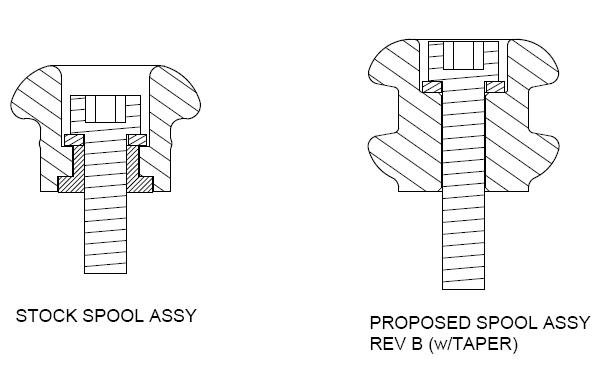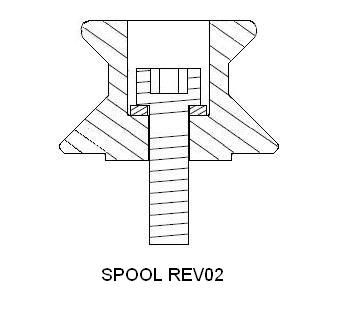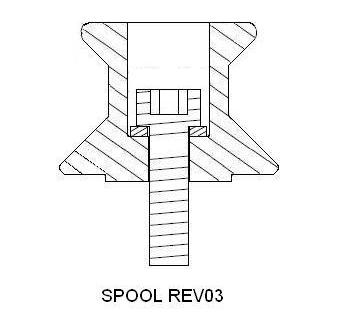| Author | Message | ||
Jersey_thunder |
BEARINGS...So they spin when lifting my .02 jt | ||
Dwiggs |
I dig the idea of bearings, but how much would that add to the cost? | ||
Skully |
Lots of good points folks. Here is Nick's spool with a slight draft on both sides of the groove:  Let me know which version you like best: A) The rounded design or B)The angular design Thanks, Keith | ||
D_adams |
If you're doing these manually, I'd guess the angular design would be easier to manufacture. If it's done in a turret lathe, I guess it wouldn't matter all that much. Maybe offer both versions? The set I made for myself took about 20 minutes the first time doing it on a Jet lathe. | ||
Skully |
All of our sliders are machined on a CNC lathe. With the quantity we've sold, getting the consistency that I require manually would have put some poor machinist in the grave! Keith | ||
Dwiggs |
Keith, the round design with the taper looks great. | ||
A_s_r |
I agree, REV B (W/ TAPER) looks very good. | ||
Zac4mac |
I keep looking at the OEM design and wondering if there isn't a "tear-off" function built in. Looks like, on hard enough side force(enough to damage the swingarm?) the cap would tear away and absorb rather than transmit the force? | ||
D_adams |
Zac, that also adds the question, what's the stock bolt made of? aluminum, mild steel or something harder yet? | ||
Blake |
"Blake, Your design does not leave much aluminum to actually support the bike. You have very little bearing surface on the bolt shank unlike the designs proposed above. ac" Good point. That does look a bit thin. What do you figure the design load on the spool is? At most 400 LBs (two people sitting on the bike while on the stand). In terms of stress, about nil. Given 60601-T6, the stresses are ridiculously low. The OEM spool is plastic with a tiny aluminum insert, yes? As noted, if needed, cut a relief to allow the protective tapered flange near the swingarm. Having some experience at the track trying to urgently get bikes on lifts, the added flair(s) to help guide the stand onto the spools is very helpful and also welcome as an aid to protecting the swingarm from damage due to being hit by the stand.  | ||
Blake |
Might also consider increasing the bearing area where stand contacts spool. If the stand isn't perfectly adjusted to the exact width between the two spools the stand won't engage reliably. Something maybe more like...  | ||
Avc8130 |
Blake, The material selected has no direct bearing on the stresses. The stresses are independent the material. Material must be selected to withstand the stresses. I have not done FEA, and I don't plan on it since this isn't MY design and I have no financial reason to do any REAL design work. I just like to work on the side of caution when engineering from the hip. The factory design puts aluminum AND bolt directly under the area the stand forks should hit. Your proposals put air. ac | ||
D_adams |
Blake, did you get the info I sent you? I replied to your email, never got a response back. Thx, Dean | ||
1324 |
Blake, The OE spool is plastic, and the insert is small. However,the size of the insert has nothing to do the function. It's hard to see in the cross section, but the stock spool actually has a molded rib in the lift 'groove'. That rib lines up directly with the edge of the aluminum insert, so it is almost like the factory put that there to force people to put the stands on the inside of the ribs (toward the swingarm). Fair strategy except that it is too close the swingarm, especially once you consider the angle on the swingarm. At any rate, the stock spool relies on the aluminum insert's bearing area to lift because the stock spool is plastic. You are correct that stresses are low (regardless of material), but why sell ourselves short on strength for the sake of bolt length? Shallower c'bore would require less machine time...if we're counting. Of course, this is just my opinion on the matter. Not claiming gospel here, so take it for what it's worth. The angled inside guide would serve the purpose nicely, I agree. The rounded shape was selected to mirror the outside shape...which was retained to give a stock look...and reduce machine time. No other reasons. Bearing area (groove) was selected to accommodate a 3/16" spool lift bracket plus about a 1/16" clearance. D, My stock bolts were some grade steel. I'll take a look at them tonight to confirm grade, but they definitely weren't aluminum. -In general, and not directed at anyone in particular- Having any spool on the swingarm will increase risk of damage during a spill. Hence why Keith is looking to offer a complete slider/spool package. If you want maximum safety, get some axle sliders and remove the spools when not in use. Of course, Keith can correct me if I'm speaking out of turn. | ||
Blake |
Avc, <sigh> Can you give me some credit here for knowing a little about what we speak? I've been a professional stress analyst for over 25 years. Yes, more material is stronger. However, 6061-T6 Aluminum alloy is MUCH stronger than plastic. In bending, peak stress is proportional to the depth squared, in our case the diameter, squared. Therefore, with the aluminum moved from the inner to the outer diameter, the strength of the section is increased by a HUGE margin, despite the inner diameter now consisting of "air" as you say. In the OEM, the aluminum insert must carry ALL the shear loading. Its area for that is tiny compared to the hollowed out all aluminum version. The applicable structural section, a hollow circular section, relative to the loads is VERY robust. I mean VERY robust. It's good to go. Absolutely no worries.  The weak link is the screw and the female aluminum threaded connection in the swingarm. It's possible the OEM spool is designed to fail before damaging the swingarm. Might not be a bad idea. The weak link is the screw and the female aluminum threaded connection in the swingarm. It's possible the OEM spool is designed to fail before damaging the swingarm. Might not be a bad idea. FEA is not required. This is a very simple problem. My/I and VQ/Ib. Give it a shot. (Message edited by blake on December 10, 2009) | ||
Blake |
Dean, I'll take a look at my email and get back to you asap. | ||
Blake |
1234, Are you sure that "rib" is molded in? Looks to me like it could easily be deformation in the plastic as a result of installation after tightening the screw. | ||
1324 |
^^^Positive. The plastic part is not loaded when the bolt is tightened. There is clearance on all interfaces. | ||
Sl33py |
I Like rev02 or 3 that have the inside angled bit to help the spool seat w/o scratching the swingarm. | ||
Blake |
1234, So then the plastic spool part spins freely in place after installation? | ||
1324 |
One of mine spins, the other binds and barely spins. Regardless, you can tell its molded by looking at it. | ||
Avc8130 |
I can spin my plastic parts when the bolt is tightened. That is the whole point of the aluminum insert. It provides the structural support. | ||
Blake |
It provides the structural support. Bingo! And it is tiny, yes? | ||
Avc8130 |
And it where the fork goes, yes? I dont get this whole redesign of the wheel effort. It is a fricken swingarm spool. Frankly just about ANYTHING will work. Design something short that doesn't interfere with the swingarm and keeps the forks from rubbing on the swingarm. That was the design objective. It was met with the VERY FIRST design proposal. | ||
Xtreme6669 |
lets get this thing done so I can order a set. What is the web-site that will be selling them? | ||
1324 |
http://www.darkhorsemoto.com/ | ||
Xtreme6669 |
Sweet, Thanks | ||
Blake |
"And it where the fork goes, yes? " Which may be important in the OEM plastic spool, but entirely inconsequential for a 6061-T6 all aluminum alloy spool, yes? "I dont get this whole redesign of the wheel effort. It is a fricken swingarm spool. Frankly just about ANYTHING will work. Design something short that doesn't interfere with the swingarm and keeps the forks from rubbing on the swingarm. That was the design objective. It was met with the VERY FIRST design proposal." My apologies. I hadn't realized that the project manager had cut off our R&D budget. It seems that constructive criticism may not be welcome here by some. Discussing engineering issues and designs is something that I very much enjoy. Sorry to have caused trouble. | ||
Blake |
 | ||
1324 |
That is a sweet looking boss. Mine look like they were welded on by a blind monkey. That one looks cast in from this angle! |